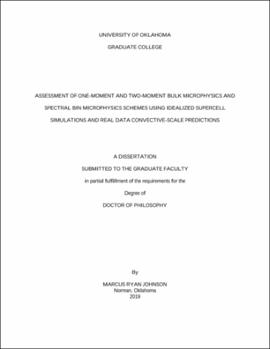| dc.description.abstract | Optimal hydrometeor parameterization and their associated processes in microphysics schemes (both spectral bin and bulk) continue to evolve as these schemes attempt to match observed hydrometeor complexity. This dissertation spans several flavors of microphysics schemes: the one-moment Unified Model (UM), the partially-two moment Thompson and Morrison with one rimed ice category, the two-moment Milbrandt-Yau (MY2) and National Severe Storms Laboratory (NSSL) with two rimed ice categories, the Predicted Particle Properties (P3) with multiple mass assumptions within its ice particle size distributions (PSDs), and the spectral bin Hebrew University Cloud Model (HUCM). Microphysical performance (including their bias documentation) is examined in idealized supercell simulations by considering cloud ice and snow moment (and their associated budget) evolution, cloud ice and snow PSDs, low-level classic polarimetric radar signatures (ZDR arc and hail signature in the forward flank downdraft), and ice hydrometeor contoured frequency by altitude diagrams (CFADs). Two test cases over the Korean Peninsula (Changma front and Typhoon Sanba [2012]) are compared to S-band radar observations by applying a dual-polarization radar variable simulator to UM output. 2018 NOAA Hazardous Weather Testbed (HWT) Spring Experiment seasonal forecasts over much of the continental United States (CONUS) and four select convective line cases are both quantitatively and qualitatively compared to observed composite reflectivity, accumulated precipitation, and brightness temperature in the 11.2 μm channel for short-term (t = 1 – 6 forecast hours) and next-day (t = 12 – 36 forecast hours) forecasts.
UM microphysics struggles to match observed dual-pol variables because of its one-moment parameterization of rain, specifically its rain PSD intercept parameter N0 diagnosis. As N0 varies inversely with rain mass, the scheme is producing too many small (large) drops in regions of too weak (intense) reflectivity. Both the fully two-moment MY2 and NSSL schemes are able to simulate a local maximum of ZDR near the forward flank edge and a gradual decrease in the direction of the deep-layer storm relative mean wind vector, but the large, dry hail in the MY2 scheme reduces ZDR on the edge of the supercell, while the NSSL’s ZDR arc is less elongated compared to typical observations. The P3 scheme with two ice categories is unable to simulate either signature, due to the restrictive rain and ice PSD slope Λ limiters (both directly and indirectly) preventing larger particles. In idealized supercell simulations, the HUCM and NSSL schemes simulate larger ice crystal moments than snow, while the Thompson scheme simulates more snow mass. This is due to the aggressive cloud ice to snow conversion in the scheme, which is intended given the assumed snow PSD. The flexible spectral bin HUCM PSDs simulate less small snow particles than the rigid bulk NSSL and Thompson schemes, but also sediments too large snow to the surface.
Over the 2018 NOAA HWT Spring Experiment, the Morrison scheme displays a large-scale storm structure (Z ≥ 15 dBZ) overprediction bias for short-term forecasts that lessens for next-day forecasts, and is likely due to enhanced horizontal graupel advection in the scheme because of its smaller fall speed. Both the NSSL and Thompson schemes underpredict this storm structure. The Morrison and NSSL schemes both overpredict convective storm structure (Z ≥ 40 dBZ), due to overadvected Morrison graupel melting to large rain, and the “large hail” category design in the NSSL scheme. Each BMP underpredicts light and heavy surface precipitation, indicating that the BMPs underpredict either total column mass and/or its sedimentation to the surface. The documented shortcomings and biases in this dissertation are essential to numerical modelers and their users alike, as users should select the appropriate scheme for their simulated storm, and numerical modelers can optimally tune/construct their microphysics scheme. | en_US |
